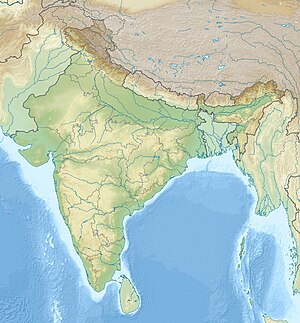| Mathura lion capital | |
|---|---|
 The Mathura lion capital on display in the Sir Joseph Hotung Gallery for China and South Asia, at the British Museum. | |
| Material | Red Sandstone |
| Size | Height 34cm Width 52.5cm |
| Writing | Prakrit inscription written in Kharoshthi script |
| Created | 1–10 CE |
| Discovered | Mathura in Central India |
| Present location | British Museum, London |
 Mathura (Discovery) | |
The Mathura lion capital is an Indo-Scythian sandstone capital (a part of a pillar) from Mathura in Northern India, dated to the first decade of the 1st century CE (1–10 CE).[1] It was consecrated under the rule of Rajuvula, one of the Northern Satraps of the region of Mathura.
The capital was unearthed at the Saptarishi mound of Mathura by Bhagwan Lal Indraji in 1869.[2] It is covered with Prakrit inscriptions in the kharoshthi script of northwestern India.[3] The capital was made on the occasion of the funeral of "the illustrious king Muki and his horse" (Muki has been conjectured to be Maues).
The capital describes, among other donations, the gift of a stupa with a relic of the Buddha, by Queen Ayasia, the "chief queen of the Indo-Scythian ruler of Mathura, satrap Rajuvula". The Mathura lion capital, an Indo-Scythian sandstone capital from Mathura in Central India, and dated to the 1st century CE, describes in kharoshthi the gift of a stupa with a relic of the Buddha, by queen Nadasi Kasa, "the wife of Rajuvula" and "daughter of Aiyasi Kamuia", who is mentioned as the "daughter of Kharahostes". The lion capital also mentions the genealogy of several Indo-Scythian satraps of Mathura. It mentions Sodasa, son of Rajuvula, who succeeded him and also made Mathura his capital.
The capital also displays at its center a Buddhist triratana symbol, further confirming the involvement of Indo-Scythian rulers with Buddhism.
The inscription indicates support of the Sarvastivadin, against the Mahasamghikas.[4]
It is on display in the South Asia section of the Sir Joseph Hotung Gallery for China and South Asia at the British Museum.
- ^ Salomon, Richard (July 1996). "An Inscribed Silver Buddhist Reliquary of the Time of King Kharaosta and Prince Indravarman". Journal of the American Oriental Society. 116 (3): 442. doi:10.2307/605147. JSTOR 605147.
- ^ Jason Neelis (19 November 2010). Early Buddhist Transmission and Trade Networks: Mobility and Exchange Within and Beyond the Northwestern Borderlands of South Asia. BRILL. p. 122. ISBN 978-90-04-18159-5.
- ^ "Red Sandstone Pillar Capital". British Museum. Archived from the original on 16 December 2010. Retrieved 1 August 2010.
- ^ Rosenfield, John M. (1967). The dynastic art of the Kushans. University of California Press. p. 134.